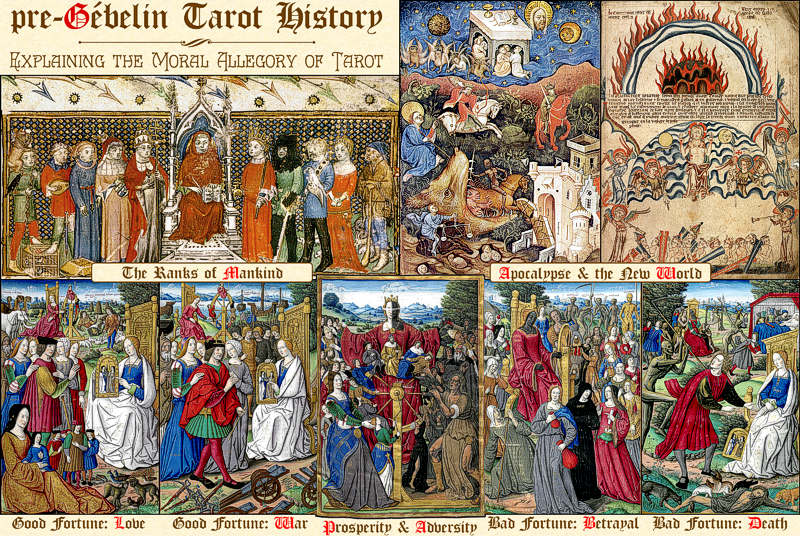The previous post contrasted the manner in which a modern Tarot enthusiast might look at Catholic iconography (e.g., declaring a personification of Ecclesia to be an evil Egyptian magician, with a tail!) with the way in which a rational person might interpret the same image, based on copious evidence from the period including many dozens of cognate examples. Tarot was an inspirational card game created by 15th-century Italian Catholics for the enjoyment of 15th-century Italian Catholics, and that is the only proper context for interpreting the moral allegory of the trump cards. The trump cycle has much in common with other moral allegories of the time, (including various Triumph of Death and Dance of Death works), with other allegorical cycles (including Boccaccio's Amorosa Visione and Petrarch's I Trionfi), and with the immensely influential catalogs of Fortune, Boccaccio's encyclopedia of moralized biography De Casibus, and Petrarch's encyclopedia of moralized circumstance, De Remediis. This was the stuff of mainstream pop-culture Italy in the 15th century.


Michael Dummett (The Game of Tarot, 1980, and other works) was himself a Catholic, and that may be one reason why he was never deceived by the fools and charlatans of the Tarot community and their two centuries of anti-Catholic folklore. Another modern Roman Catholic -- one who has also spent many years involved with all manner of games -- is currently presenting a summary analysis of Tarot history. Thomas L. McDonald is nearly finished with a series of blog posts on the "real history" of Tarot. Many of his conclusions are the same as any other rational person's might be, and vastly better than might be found on a Tarot "history" forum. (He even discusses Ross' translation of Bishop Wibold's devotional game.) McDonald just uploaded the post which I was waiting for, on the meaning of the cards, so we'll post some links and comments.

1. Reclaiming Tarot (July 3, 2013)
http://www.patheos.com/blogs/godandthemachine/2013/07/reclaiming-tarot/
2. The Real History of Tarot (July 3, 2013)
http://www.patheos.com/blogs/godandthemachine/2013/07/the-real-history-of-tarot/
3. On Divination (July 3, 2013)
http://www.patheos.com/blogs/godandthemachine/2013/07/on-divination/
4. The Bishop’s Dice Game (July 15, 2013)
http://www.patheos.com/blogs/godandthemachine/2013/07/the-bishops-dice-game-tarot-series/
5. The Fake History of Tarot (July 16, 2013)
http://www.patheos.com/blogs/godandthemachine/2013/07/the-fake-history-of-tarot/
6. The Meaning of the Cards (July 21, 2013)
http://www.patheos.com/blogs/godandthemachine/2013/07/the-meaning-of-the-cards-tarot-series/
7. Playing Tarot (link added 7/23/13)
http://www.patheos.com/blogs/godandthemachine/2013/07/how-to-play-tarot-an-explanation-with-sample-rules/
8. Meditations on the Tarot (link added 7/24/13)
http://www.patheos.com/blogs/godandthemachine/2013/07/meditations-on-the-tarot/

Sadly, McDonald has adopted the typical pop-culture approach to interpreting the cards, taking the images out of context and cherry picking a preferred reading for each. He offers more reasonable interpretations than most Tarotists, because his bias is appropriate to the subject matter, and he has therefore accepted the findings of playing-card historians. For example, two of the subjects which have baffled generations of Tarot enthusiasts are the Popess and the Traitor. McDonald gets them both right, but he fails to understand what they're doing in the series.
Some cards appear to be a puzzlement. La Papessa (The Popess/Papess) is often wildly misread as a reference to the mythical figure of “Pope Joan,” a “female pope” who never actually existed. The answer is actually far more mundane: The Popess would represent the association of the Pope with Rome or the Church, which would be depicted as feminine figures (eg, “Holy Mother Church”). It’s simply an allegorical image.
This is very good, as far as it goes. But what is the Church doing as one of the lowest of the trumps, triumphed over by almost every other subject? Was Tarot created by heretics, or perhaps by proto-Protestants?
Similarly, The Hanged Man mystified some people with its image of a man hanging from a scaffold by his left foot. Gallons of ink have been spilled trying to figure out What It Could Possibly Mean. In fact, it was a Northern Italian method of execution for traitors. That’s it. Researcher Timothy Betts finds evidence for this in a 1393 decree for Milan and Lombardy: “Let him be drug on a [wooden] plank at a horse’s tail to the place of execution, and there be suspended by one foot to the gallows, and be left there until he is dead. As long as he lives let him be given food and drink.”
McDonald has this subject, the Hanged Man, identified as clearly and correctly as the Popess. (He even cites Timothy Betts, Tarot and the Millennium, 1998.) Of course, this basic identification has been well known for decades, since Moakley (The Tarot Cards Painted by Bonifacio Bembo, 1966), and it is still presented out of context. Without the sequential context of the entire sequence there is little understanding to be gained. Does the relatively high rank of the Hanged Man, in the middle of the cycle, mean that Tarot is celebrating evil? Why would a Traitor triumph over the Holy Roman Emperor and the Vicar of Christ, or over the three Moral Virtues? McDonald's problem is that he ignores the central question re Tarot's meaning: What is this figure doing in the trump cycle? Why does he follow cards like the Triumphal Chariot and Love, then Time and Fortune, and why does he precede Death? Overall, however, McDonald has done the most important things a writer on Tarot can do: Start with Dummett; remember that Tarot was and is a game; and remember that the trump cycle was created by Roman Catholics, for Roman Catholics.




